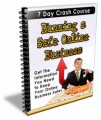Salespage Snapshot:

Table of Contents
Table of Contents 3
Introduction 5
Market Research Basics 6
Identify the Competition 7
Identify the Buyer 9
Determine Product Features 11
Establishing a Pricing Strategy 14
Conclusion 17
Resources 18
Sample Content Preview
Market Research Basics
Market research, simply defined, is analyzing your market, currently available products and competitors, and your target customers. Ideally, it’s done before any product development begins, but it can also be done at a later date (perhaps with a less potent effect).
There are two basic ways to conduct market research:
1. Primary Research – This is going directly to individuals in the form of interviews, surveys, etc.
2. Secondary Research – This is doing research online, identifying your competitors, doing an analysis of currently published data, etc.
Many people think of market research as mostly the primary type, specifically that type of research done by market research companies that use surveys and questionnaires to conduct their research, however secondary research is often just as powerful, and it’s also accessible to everyone.
Since interviewing people is very time consuming and often expensive, a lot of beginning entrepreneurs simply cannot manage it, and hiring a market research firm can cost thousands of dollars, we are going to concentrate on secondary research, which anyone with access to the internet can conduct.
Identify the Competition
Everyone has competition. Even if you invent something completely new and unique, you will have competition. It may be in the form of a similar existing product, or it may be people copying you after you launch your product, but you will have competition.
What you must do is figure out who your main competitors will be, and how you can do things better than they do.
Let’s say you want to create a new type of iPhone case that will revolutionize the market. You may get a patent on this case, but a patent will only give you 14-20 years of protection, and even then people find ways around the patent by making certain changes to the design or utility of the product.
Your main competition would be companies like OtterBox, and any of the other thousands of companies that create iPhone cases.
What you’d want to do is make a list of the top 5-10 companies that are your main competition, and start analyzing them for strengths and weaknesses.
Let’s take OtterBox, for example. You can do basic market research on the company by visiting a retailer’s website like Amazon or Best Buy and looking for reviews.
Clearly, their products are made well. Customers seem to enjoy the durability of their cases, but a number of people complain about the ease of use. That would be a place where a competitor could take advantage.
Additionally, their products are priced considerably higher than the competition, which is another weakness a competitor could potentially exploit.
People also complain about a lack of color options, which could be another weakness one might use to their advantage.
Of course, you must look at the other end of the spectrum. OtterBox is one of the only higher-priced companies making iPhone cases. The vast majority of manufacturers are concentrating on the lower end market, pricing their products much lower than OtterBox. Thus, the market for low priced options is already flooded.
In this case, the most likely option would be to create a higher end product similar to OtterBox, make the product easier to use and have more style options, and price slightly below OtterBox in order to compete. You could always raise prices later, once your name has been established.
As you can see, identifying the competition can be extremely useful when deciding to enter a particular market, because you can identify the weaker segments in the market and target those, as opposed to going straight for the more competitive segments.
Identify the Buyer
Next, it’s important to identify your average buyer. Never assume you know who is most likely to buy your product, because you could be very wrong and end up targeting the wrong demographic entirely.
One might assume, for example, that their average buyer was going to be younger women, when in actuality it could turn out to be women in their fifties. You might think this wouldn’t be a big deal, but if you’re using demographic targeting for your advertising, you could lose a lot of money if you target the wrong group.
Additionally, identifying the wrong demographic could cause you to gear your product toward the wrong audience, resulting in a less than stellar reception by your actual audience—that is, those people who are in your real target demographic and actually end up buying the product.
Identifying your buyer isn’t always easy. It may take a combination of tactics, from interviewing people to checking out the demographics of your competitors, but this research can be invaluable when it comes to product creation and ad targeting.
You might want to try to reverse engineer your market by taking an educated guess about who you think your average buyer would be, and then find some of the people that fit your demographic in order to ask them their opinions about your product (or your potential product.)
Find out if they’d be interested in such a product, how much they might be willing to pay, and what key featured they would expect the product to have. You can offer them the product for free in exchange for their opinion, if you like. Get their contact information and send them the product after it is complete.
If you get a very good response from your target demographic, you know you’ve probably found the correct market for your product. Otherwise, you may have to revise the target demographic and try again.
Here is a good article on finding your target market:
http://www.inc.com/guides/2010/06/defining-your-target-market.html
Determine Product Features
Another reason knowing your competition and target market is so important is so you can decide which features your product should have. It’s probably tempting to pack in every feature you can think of, but all this will do is end up in a convoluted mess of a project that will likely have to cost more than your market can bear.
Instead, it’s important to focus on a few key features that your market really expects and desires rather than adding a bunch of additional features that most people could live without. The more features you add, the more it costs you to produce, and the higher your price will have to be. That’s alright if you specifically aim to target very wealthy buyers, but generally you want to keep your relatively price low in order to remain competitive.
The first thing you need to do is take a look at your biggest competitors. Make a list of the key features of each of their products and look for any areas where you might improve.
Again, read those online reviews to find out what people are saying about each product—good and bad. Find out what they think is missing, and what they really love about each product made by your competitors.
One great way to determine which features to include in your product and which to exclude is to gather your team together (or a focus group within your target demographic) and give each individual a stack of currency (such as play money or Monopoly money) and have them each assign their cash according to which features they feel most passionately about.
They can put all their cash onto a single feature if they are extremely passionate about it, or distribute it in any way they see fit as long as they distribute all of their cash.
Those features that have the highest amount of money distributed to them make it into the finished product, and the rest are cut.
Another way to determine product features is using what is known as the Kano Model. In the Kano Model, you figure out which features are going to raise customer delight the most and make sure you include those, while also including the basic features that every product in the market must have and some “performance” features that help boost customer satisfaction proportionately but don’t have that “WOW!” factor.
Other Details- 1 Ebook (PDF, DOC), 18 Pages
- 7 Part Autoresponder Email Messages (TXT)
- 1 Squeeze Page (HTML, PSD)
- File Size: 6,909 KB












